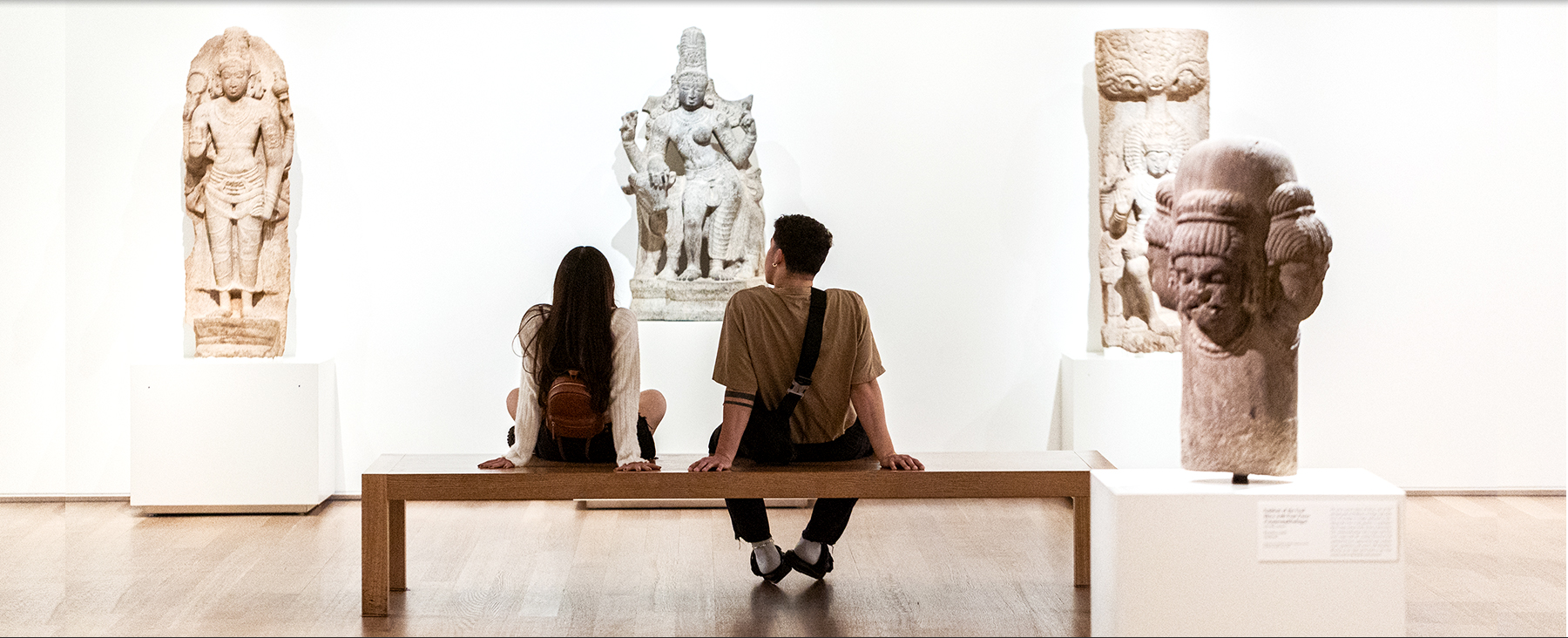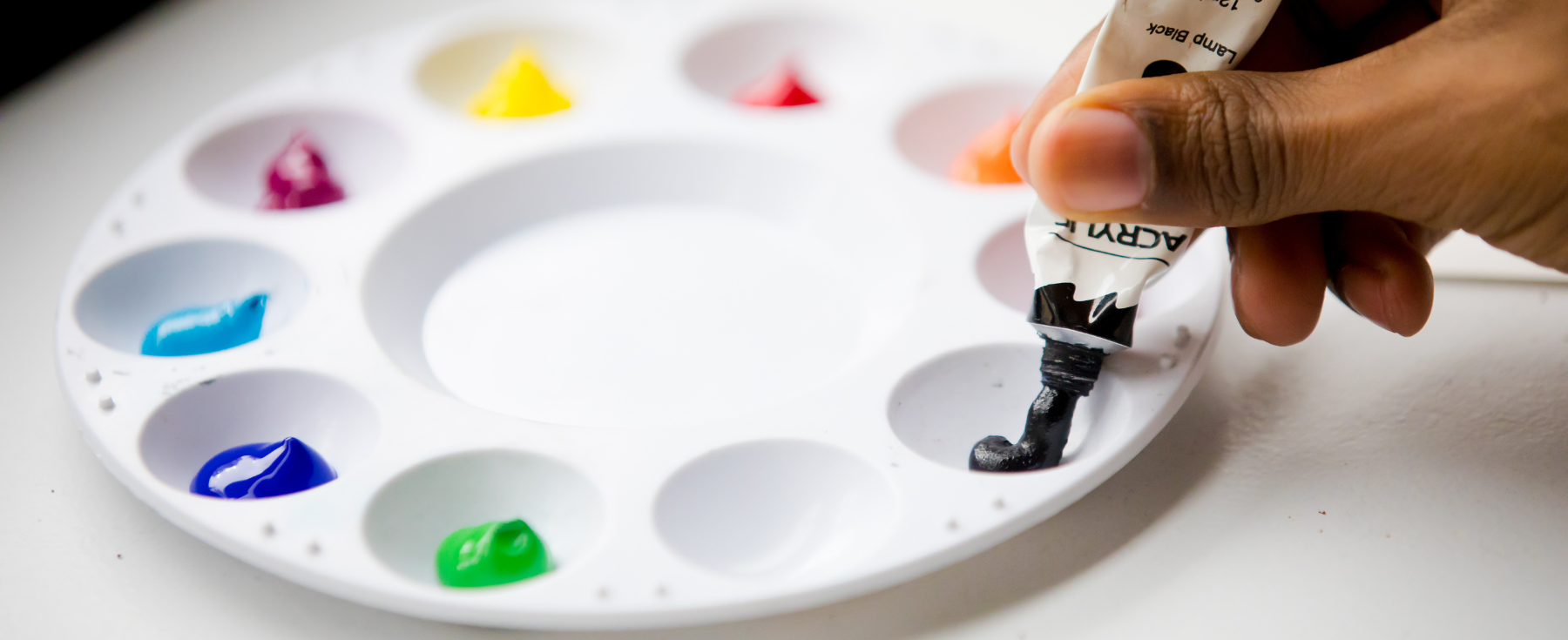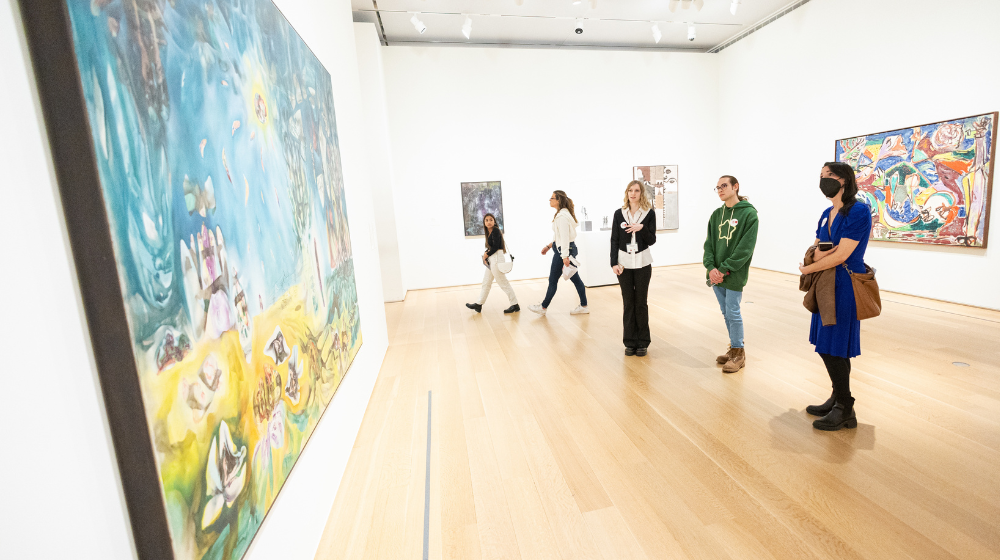
The ARtS Initiative
The ARtS Initiative
PROMOTING MULTIPLE PERSPECTIVES AND CRITICAL THINKING THROUGH ART-BASED INQUIRY
Dr. Seungho Moon, a professor in the Teaching and Learning program at the School of Education, created the ARtS (Aesthetic, Reflexive thoughts, and Sharing) Initiative to help students and community members understand inter-cultural relationships and exchange points of view from different backgrounds. Moon promotes multiple perspectives and critical thinking through art-based inquiry, where art expands beyond a private domain and into a public space where people engage in social issues and challenge what they have taken for granted about their previous beliefs. He uses paintings, pottery, poetry, and dance, as well as other forms of art that are all over the city of Chicago as learning opportunities.
It began in 2013 in Oklahoma, when Moon created the program before extending it at Loyola using active partnerships with local schools and their families. Measuring the program’s effect is difficult as it is not based on quantitative data. Instead, the initiative is grounded in “aesthetic education,” which engages students in their learning through hands-on inquiry. It also fights against social numbness in education, which is when a default narrative has been taught in a way that disregards the viewpoints of many underrepresented people. Moon uses art in the Chicagoland area and the ARtS principles to help people think about how the artwork’s narrative can be dramatically different if it is looked at through a contrasting social, gendered, or racial lens.

Moon wants the program to be culturally responsive to Chicago, one of the most segregated cities in the United States. By using art as a framework for people to look at themselves and others from different standing points, he encourages people to ask questions without bias or previous assumptions that may harm others. He also wants people to use the different cultural narratives of art to understand their positions of privilege by asking questions and performing critical self-reflection. Doing this can lead them to actions that better support each other, like saying, “I’m here, and let me know what I can do.”
The ARtS Initiative allows people to engage with art on a different level than they normally would. Moon guides people to look at and live in the world differently, using artwork as a vessel. He’ll often spend at least half an hour discussing one piece of art with his group, dissecting the details that when changed, change the artwork as a whole. When discussing this impact on people, he said that “changes may happen right away, yet true transformation takes time.” Students, families, and community members can enjoy it differently while taking away something insightful that can broaden their perspectives.
"Changes may happen right away, yet true transformation takes time." Dr. Seungho Moon
When he first began, Moon ran the ARtS initiative as an afterschool program, where he tried to get artists into schools. Now, he has extended the program to collaborate with local museums and cultural institutions in the city of Chicago, where he points out that the trips are not designed to be guided tours. There is no fixed format for implementing the program, his job is to just be a facilitator asking questions and inspiring people to engage actively with the art and reflect on their impressions of it.
One key example Moon gave involved Grant Wood’s iconic 1930 painting, American Gothic, specifically, how the historical and political context of the painting shapes a very specific narrative about the two subjects. When he and his participants visited the painting at the Art Institute of Chicago, he asked how the portrayal of the painting shifts if the woman in the painting, Nan, is changed to a Black woman. He said that the most common reaction to a question like that being posed is for the audience to pause, think, and then start sharing completely different ideas about this Black woman’s life in 1930 rural America instead of a white woman’s.

Dr. Seungho Moon is a Professor of Curriculum Studies in the Teaching and Learning Program at the School of Education.
At the program’s most recent trip to the DuSable Black History Museum, Moon invited participants to look at iconic works of Black art from different angles and with historical context. He hoped they could connect the art and the intense racial history of the United States to current experiences seen in the country, imparting the message that freedom is not free. The goal behind this is to challenge the myth of objectivity in education. When teachers are required to be objective, that can reinforce the narrative taught by the “winners” of history, not those oppressed by them. However, by intentionally introducing the subjectivity of art, Moon can draw on participants' lived experiences and facilitate discussion between them to demonstrate how that can affect one’s perception of the world around them.
Moon’s passion for empathy and cultural understanding is reflected every day as he brings the same values in the ARtS initiative to his students within Loyola's School of Education. Recently he started working as co-director of the School of Education’s 3Cs (Curriculum, Culture, and Communities) doctoral program, which was designed within a social justice framework to help future educators and other leaders positively impact learners, teachers, and communities in a globalized world. Moon wants to push students outside of their comfort zone and for them “to look at things as if they could be otherwise,” a philosophy from his former professor and mentor, Dr. Maxine Greene. A decade after its inception, the ARtS Initiative is still going strong, and Moon continues to broaden not only his student’s perspectives, but anyone who chooses to walk into his program with an open mind.

Teaching & Learning
Curriculum, Culture, and Communities
3Cs is designed within a social justice framework across schools and communities to prepare educators, community organizers, faith-based leaders, nonprofit leaders, and others to take on new challenges as socially-just educators and researchers in institutions of higher education, schools, and communities.
Learn MoreStory by Ethan Letsch
Dr. Seungho Moon, a professor in the Teaching and Learning program at the School of Education, created the ARtS (Aesthetic, Reflexive thoughts, and Sharing) Initiative to help students and community members understand inter-cultural relationships and exchange points of view from different backgrounds. Moon promotes multiple perspectives and critical thinking through art-based inquiry, where art expands beyond a private domain and into a public space where people engage in social issues and challenge what they have taken for granted about their previous beliefs. He uses paintings, pottery, poetry, and dance, as well as other forms of art that are all over the city of Chicago as learning opportunities.
It began in 2013 in Oklahoma, when Moon created the program before extending it at Loyola using active partnerships with local schools and their families. Measuring the program’s effect is difficult as it is not based on quantitative data. Instead, the initiative is grounded in “aesthetic education,” which engages students in their learning through hands-on inquiry. It also fights against social numbness in education, which is when a default narrative has been taught in a way that disregards the viewpoints of many underrepresented people. Moon uses art in the Chicagoland area and the ARtS principles to help people think about how the artwork’s narrative can be dramatically different if it is looked at through a contrasting social, gendered, or racial lens.
Moon wants the program to be culturally responsive to Chicago, one of the most segregated cities in the United States. By using art as a framework for people to look at themselves and others from different standing points, he encourages people to ask questions without bias or previous assumptions that may harm others. He also wants people to use the different cultural narratives of art to understand their positions of privilege by asking questions and performing critical self-reflection. Doing this can lead them to actions that better support each other, like saying, “I’m here, and let me know what I can do.”
The ARtS Initiative allows people to engage with art on a different level than they normally would. Moon guides people to look at and live in the world differently, using artwork as a vessel. He’ll often spend at least half an hour discussing one piece of art with his group, dissecting the details that when changed, change the artwork as a whole. When discussing this impact on people, he said that “changes may happen right away, yet true transformation takes time.” Students, families, and community members can enjoy it differently while taking away something insightful that can broaden their perspectives.
When he first began, Moon ran the ARtS initiative as an afterschool program, where he tried to get artists into schools. Now, he has extended the program to collaborate with local museums and cultural institutions in the city of Chicago, where he points out that the trips are not designed to be guided tours. There is no fixed format for implementing the program, his job is to just be a facilitator asking questions and inspiring people to engage actively with the art and reflect on their impressions of it.
One key example Moon gave involved Grant Wood’s iconic 1930 painting, American Gothic, specifically, how the historical and political context of the painting shapes a very specific narrative about the two subjects. When he and his participants visited the painting at the Art Institute of Chicago, he asked how the portrayal of the painting shifts if the woman in the painting, Nan, is changed to a Black woman. He said that the most common reaction to a question like that being posed is for the audience to pause, think, and then start sharing completely different ideas about this Black woman’s life in 1930 rural America instead of a white woman’s.
At the program’s most recent trip to the DuSable Black History Museum, Moon invited participants to look at iconic works of Black art from different angles and with historical context. He hoped they could connect the art and the intense racial history of the United States to current experiences seen in the country, imparting the message that freedom is not free. The goal behind this is to challenge the myth of objectivity in education. When teachers are required to be objective, that can reinforce the narrative taught by the “winners” of history, not those oppressed by them. However, by intentionally introducing the subjectivity of art, Moon can draw on participants' lived experiences and facilitate discussion between them to demonstrate how that can affect one’s perception of the world around them.
Moon’s passion for empathy and cultural understanding is reflected every day as he brings the same values in the ARtS initiative to his students within Loyola's School of Education. Recently he started working as co-director of the School of Education’s 3Cs (Curriculum, Culture, and Communities) doctoral program, which was designed within a social justice framework to help future educators and other leaders positively impact learners, teachers, and communities in a globalized world. Moon wants to push students outside of their comfort zone and for them “to look at things as if they could be otherwise,” a philosophy from his former professor and mentor, Dr. Maxine Greene. A decade after its inception, the ARtS Initiative is still going strong, and Moon continues to broaden not only his student’s perspectives, but anyone who chooses to walk into his program with an open mind.
